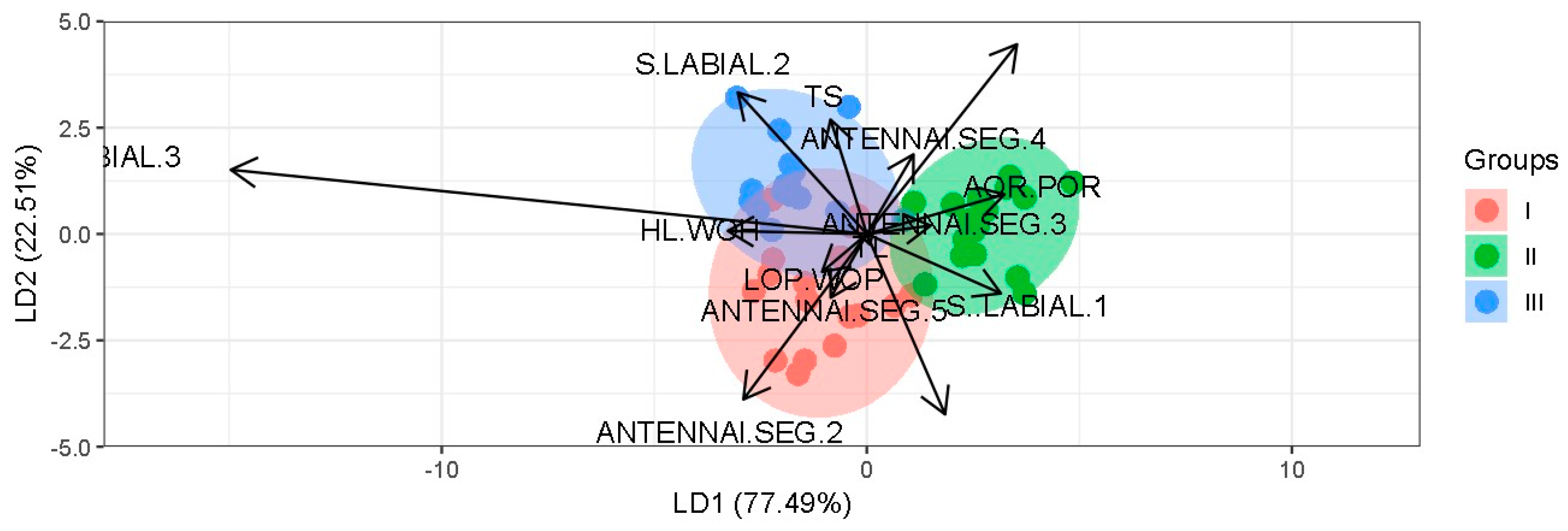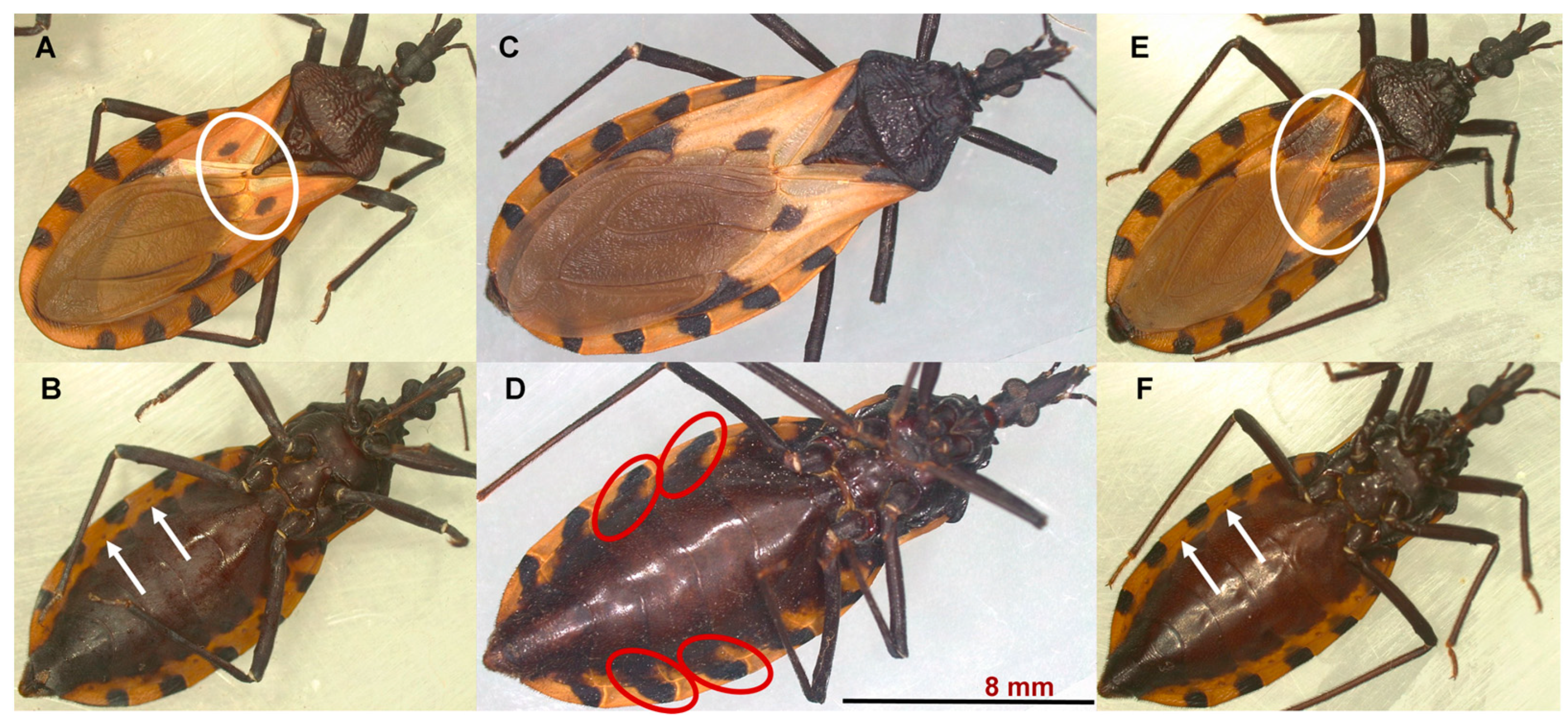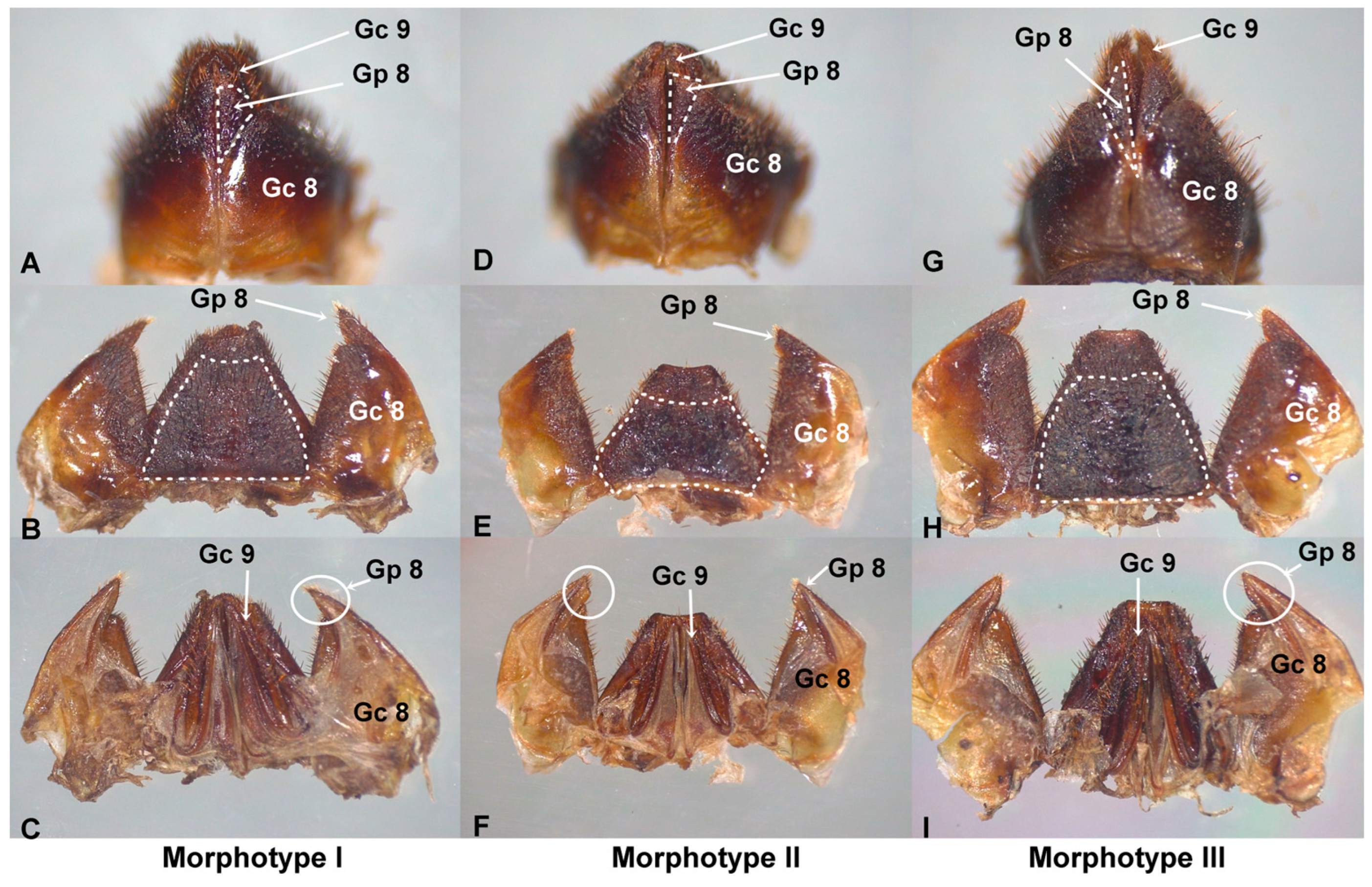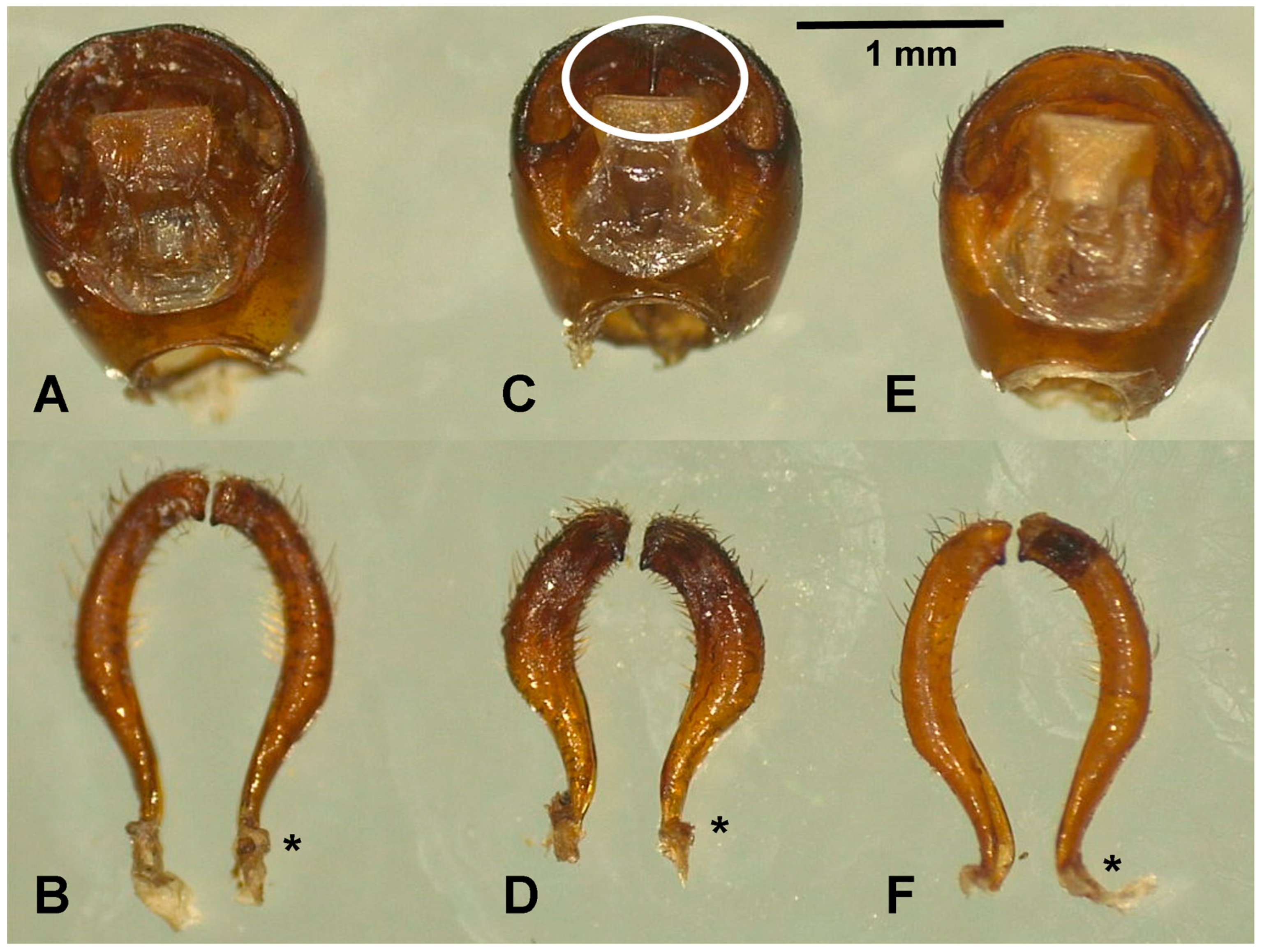Morphometry and Morphology of the Body and External Genitalia of Triatoma dimidiata (Hemiptera: Reduviidae) Morphotypes
Abstract
1. Introduction
2. Materials and Methods
2.1. Triatomine Collection
2.2. Morphotypes of T. dimidiata
2.3. Morphometric Parameters of the T. dimidiata Morphotypes
2.4. External Genitalia of the T. dimidiata Morphotypes
2.5. Data Analysis
3. Results
3.1. Abundance and Distribution
3.2. Body Measurements and Morphology per Morphotypes
3.3. External Genitalia per Morphotypes
4. Discussion
5. Perspective
Supplementary Materials
Author Contributions
Funding
Data Availability Statement
Acknowledgments
Conflicts of Interest
Appendix A
| Variable | LD1 | LD2 |
|---|---|---|
| TL | 0.0746642 | −0.248155 |
| LOP/WOP | −1.052806 | −0.889712 |
| AOR/POR | 3.2371953 | 0.9324774 |
| SYN | 10.852682 | 13.463025 |
| HL/WOH | −3.268681 | 0.0726561 |
| WE | 5.371945 | 10.239435 |
| TS | −0.85398 | 2.6913045 |
| POS | 1.8417671 | −4.239118 |
| ANTENNAl.SEG.1 | 3.5317678 | 4.461134 |
| ANTENNAl.SEG.2 | −2.902931 | −3.888127 |
| ANTENNAl.SEG.3 | 1.5002307 | 0.197906 |
| ANTENNAl.SEG.4 | 1.0978322 | 1.872826 |
| ANTENNAl.SEG.5 | −0.849266 | −1.495951 |
| S..LABIAL.1 | 3.153749 | −1.397268 |
| S.LABIAL.2 | −3.035265 | 3.3296145 |
| S.LABIAL.3 | −14.96195 | 1.5103849 |
Appendix B

References
- World Health Organization (WHO). Chagas disease (American trypanosomiasis). Available online: https://www.who.int/health-topics/chagas-disease#tab=tab_1 (accessed on 15 September 2025).
- Pech-May, A.; Mazariegos-Hidalgo, C.J.; Izeta-Alberdi, A.; López-Cancino, S.A.; Tun-Ku, E.; Cruz-Félix, K.D.L.; Ibarra-Cerdeña, C.N.; Ittig, R.E.G.; Ramsey, J.M. Genetic variation and phylogeography of the Triatoma dimidiata complex evidence a potential center of origin and recent divergence of haplogroups having differential Trypanosoma cruzi and DTU infections. PLoS. Negl. Trop. Dis. 2019, 13, e0007044. [Google Scholar] [CrossRef]
- Becker, I.; Miranda-Ortiz, H.; Fernández-Figueroa, E.A.; Sánchez-Montes, S.; Colunga-Salas, P.; Grostieta, E.; Juárez-Gabriel, J.; Lozano-Sardaneta, Y.N.; Arce-Fonseca, M.; Rodríguez-Morales, O.; et al. The Low Variability of Tc24 in Trypanosoma cruzi TcI as an Advantage for Chagas Disease Prophylaxis and Diagnosis in Mexico. Pathogens 2023, 12, 368. [Google Scholar] [CrossRef] [PubMed]
- Alevi, K.; Oliveira, D.J.; Rocha, D.D.S.; Galvão, C. Trends in Taxonomy of Chagas Disease Vectors (Hemiptera, Reduviidae, Triatominae): From Linnaean to Integrative Taxonomy. Pathogens 2021, 10, 1627. [Google Scholar] [CrossRef]
- Téllez-Rendón, J.; Esteban, L.; Rengifo-Correa, L.; Díaz-Albiter, H.; Huerta, H.; Dale, C. Triatoma yelapensis sp. nov. (Hemiptera: Reduviidae) from Mexico, with a Key of Triatoma Species Recorded in Mexico. Insects 2023, 14, 331. [Google Scholar] [CrossRef] [PubMed]
- Carcavallo, R.U.; Jurberg, J.; Lent, H.; Noireau, F.; Galvão, C. Phylogeny of the Triatominae (Hemiptera: Reduviidae). Proposals for taxonomic arrangements. Entomol. Vect. 2000, 7, 1–99. [Google Scholar]
- Justi, S.A.; Dale, C. Designation of the neotype of Triatoma dimidiata (Latreille, 1811) (Hemiptera, Reduviidae, Triatominae), with full integrated redescription including mitogenome and nuclear ITS-2 sequences. Zookeys 2021, 1076, 9–24. [Google Scholar] [CrossRef] [PubMed]
- Bargues, M.D.; Klisiowicz, D.R.; Gonzalez-Candelas, F.; Ramsey, J.M.; Monroy, C.; Ponce, C.; Salazar-Schettino, P.M.; Panzera, F.; Abad-Franch, F.; Sousa, O.E.; et al. Phylogeography and genetic variation of Triatoma dimidiata, the main Chagas disease vector in Central America, and its position within the genus Triatoma. PLoS. Negl. Trop. Dis. 2008, 2, e233. [Google Scholar] [CrossRef]
- Dorn, P.L.; de la Rúa, N.M.; Axen, H.; Smith, N.; Richards, B.R.; Charabati, J.; Suarez, J.; Woods, A.; Pessoa, R.; Monroy, C.; et al. Hypothesis testing clarifies the systematics of the main Central American Chagas disease vector, Triatoma dimidiata (Latreille, 1811), across its geographic range. Infect. Genet. Evol. 2016, 44, 431–443. [Google Scholar] [CrossRef]
- Justi, S.A.; Cahan, S.; Stevens, L.; Monroy, C.; Lima-Cordón, R.; Dorn, P.L. Vectors of diversity: Genome wide diversity across the geographic range of the Chagas disease vector Triatoma dimidiata sensu lato (Hemiptera: Reduviidae). Mol. Phylogenet. Evol. 2018, 120, 144–150. [Google Scholar] [CrossRef]
- Dorn, P.L.; Justi, S.A.; Dale, C.; Stevens, L.; Galvão, C.; Lima-Cordón, R.; Monroy, C. Description of Triatoma mopan sp. n. from a cave in Belize (Hemiptera, Reduviidae, Triatominae). Zookeys 2018, 775, 69–95. [Google Scholar] [CrossRef]
- Lima-Cordón, R.A.; Monroy, M.C.; Stevens, L.; Rodas, A.; Rodas, G.A.; Dorn, P.L.; Justi, S.A. Description of Triatoma huehuetenanguensis sp. n., a potential Chagas disease vector (Hemiptera, Reduviidae, Triatominae). Zookeys 2019, 820, 51–70. [Google Scholar] [CrossRef]
- Lent, H.; Wygodzinsky, P.W. Revision of the Triatominae (Hemiptera, Reduviidae), and their significance as vectors of Chagas’ disease. Bull. Am. Mus. Nat. Hist. 1979, 163, 123–520. [Google Scholar]
- Cigarroa-Toledo, N.; Baak-Baak, C.M.; Chan-Pérez, J.I.; Hernandez-Mena, D.I.; Amaya-Guardia, K.C.; Ocaña-Correa, M.F.; Pech-May, A.; Acosta-Viana, K.Y. Dataset of assembly and annotation of the mitogenomes of Triatoma dimidiata and Triatoma huehuetenanguensis captured from Yucatán, Mexico. Data Br. 2024, 52, 109866. [Google Scholar] [CrossRef]
- Valdez-Tah, A.R.; Romero, D. Geografía de la enfermedad de Chagas en Yucatán: Determinantes socioeconómicos y demográficos a nivel municipal. Investig. Geográficas 2024. Available online: https://dialnet.unirioja.es/servlet/articulo?codigo=9536016 (accessed on 13 October 2025). [CrossRef]
- Herrera-Aguilar, M.; Be-Barragán, L.A.; Ramirez-Sierra, M.J.; Tripet, F.; Dorn, P.; Dumonteil, E. Identification of a large hybrid zone between sympatric sibling species of Triatoma dimidiata in the Yucatan peninsula, Mexico, and its epidemiological importance. Infect. Genet. Evol. 2009, 9, 1345–1351. [Google Scholar] [CrossRef]
- da Rosa, J.A.; Mendonça, V.J.; Gardim, S.; de Carvalho, D.B.; de Oliveira, J.; Nascimento, J.D.; Pinotti, H.; Pinto, M.C.; Cilense, M.; Galvão, C. Study of the external female genitalia of 14 Rhodnius species (Hemiptera, Reduviidae, Triatominae) using scanning electron microscopy. Parasit. Vectors 2014, 7, 17. [Google Scholar] [CrossRef]
- da Rosa, J.A.; Mendonça, V.J.; Rocha, C.S.; Gardim, S.; Cilense, M. Characterization of the external female genitalia of six species of Triatominae (Hemiptera: Reduviidade) by scanning electron microscopy. Mem. Inst. Oswaldo Cruz. 2010, 105, 286–292. [Google Scholar] [CrossRef]
- Chiang, R.G.; Chiang, J.A.; Chiang, R.G.; Chiang, J.A. Functional Anatomy of the External and Internal Reproductive Structures in Insect Vectors of Chagas Disease with Particular Reference to Rhodnius prolixus. In Biological Control of Pest and Vector Insects; Shields, V.D.C., Ed.; InTech: Rigeka, Croatia, 2017; pp. 299–324. [Google Scholar]
- Tellez-Garcia, A.A.; Bello-Bedoy, R.; Enríquez-Vara, J.N.; Córdoba-Aguilar, A.; Gutiérrez-Cabrera, A.E. Genital morphology and copulatory behavior in triatomine bugs (Reduviidae: Triatominae). Arthropod Struct. Dev. 2019, 49, 103–118. [Google Scholar] [CrossRef]
- Teves, S.C.; Gonçalves, T.C.M.; de Freitas, S.P.C.; Lopes, C.M.; Carbajal-de-la-Fuente, A.L.; dos Santos-Mallet, J.R. External female genitalia of Triatoma jatai, Triatoma costalimai and Triatoma williami (Hemiptera: Reduviidae: Triatominae). Parasit. Vectors. 2020, 13, 1–6. [Google Scholar] [CrossRef] [PubMed]
- dos Rodrigues, J.M.S.; da Rosa, J.A.; Moreira, F.F.F.; Galvão, C. Morphology of the terminal abdominal segments in females of Triatominae (Insecta: Hemiptera: Reduviidae). Acta Trop. 2018, 185, 86–97. [Google Scholar] [CrossRef] [PubMed]
- Sandoval-Ruiz, C.A.; Cervantesperedo, L.; Mendoza-Palmero, F.S.; Ibáñez-Bernal, S. The Triatominae (Hemiptera: Heteroptera: Reduviidae) of Veracruz, Mexico: Geographic distribution, taxonomic redescriptions, and a key. Zootaxa 2012, 3487, 1–23. [Google Scholar] [CrossRef]
- Reyes-Novelo, E.; Ruiz-Piña, H.; Escobedo-Ortegón, J.; Barrera-Pérez, M.; Manrique-Saide, P.; Rodríguez-Vivas, R.I. Triatoma dimidiata (Latreille) Abundance and Infection with Trypanosoma cruzi in a Rural Community of Yucatan, Mexico. Neotrop. Entomol. 2013, 42, 317–324. [Google Scholar] [CrossRef] [PubMed]
- Rebollar-Téllez, E.A.; Reyes-Villanueva, F.; Escobedo-Ortegón, J.; Balam-Briceño, P.; May-Concha, I. Abundance and nightly activity behavior of a sylvan population of Triatoma dimidiata (Hemiptera: Reduviidae: Triatominae) from the Yucatan, Mexico. J. Vector Ecol. 2009, 34, 304–310. [Google Scholar] [CrossRef]
- Moo-Millan, J.I.; Hernández-Andrade, A.; May-Concha, I.J.; Montalvo-Balam, T.; Arnal, A.; Talavera-Escalante, M.J.; Amblard-Rambert, A.; Martínez-Vega, P.P.; Ramos-Ligonio, Á.; Ibarra-Cerdeña, C.N. Temporal variation of Triatoma dimidiata abundance and infection with Trypanosoma cruzi in domestic and sylvatic habitats of rural Yucatan, Mexico. Acta Trop. 2023, 248, 107038. [Google Scholar] [CrossRef]
- Moo-Millan, J.I.; Arnal, A.; Pérez-Carrillo, S.; Hernandez-Andrade, A.; Ramírez-Sierra, M.J.; Rosado-Vallado, M.; Dumonteil, E.; Waleckx, E. Disentangling Trypanosoma cruzi transmission cycle dynamics through the identification of blood meal sources of natural populations of Triatoma dimidiata in Yucatán, Mexico. Parasit. Vectors. 2019, 12, 1–11. [Google Scholar] [CrossRef]
- Koyoc-Cardeña, E.; Medina-Barreiro, A.; Escobedo-Ortegón, F.J.; Rodríguez-Buenfil, J.C.; Barrera-Pérez, M.; Reyes-Novelo, E.; Chablé-Santos, J.; Selem-Salas, C.; Vazquez-Prokopec, G.; Manrique-Saide, P.; et al. Chicken coops, Triatoma dimidiata infestation and its infection with Trypanosoma cruzi in a rural village of Yucatan, Mexico. Rev. Inst. Med. Trop. Sao Paulo. 2015, 57, 269. [Google Scholar] [CrossRef]
- Dumonteil, E.; Tripet, F.; Ramirez-Sierra, M.J.; Payet, V.; Lanzaro, G.; Menu, F. Assessment of Triatoma dimidiata dispersal in the Yucatan Peninsula of Mexico by morphometry and microsatellite markers. Am. J. Trop. Med. Hyg. 2007, 76, 930–937. [Google Scholar] [CrossRef] [PubMed]
- Garcia-Rejon, J.E.; Tzuc-Dzul, J.C.; Cetina-Trejo, R.; Madera-Navarrete, M.I.; Cigarroa-Toledo, N.; Chan-Perez, J.I.; Ortega-Pacheco, A.; Torres-Chable, O.; Pietri, J.E.; Baak-Baak, C.M. Identification of parasitic arthropods collected from domestic and wild animals in Yucatan, Mexico. Ann. Parasitol. 2021, 67, 647–658. [Google Scholar] [CrossRef] [PubMed]
- Guzmán-Marín, E.; Barrera-Pérez, M.A.; Rodríguez-Félix, M.E.; Escobedo, F.; Zavala, J.E. Indices entomológicos de Triatoma dimidiata en el estado de Yucatán. Rev. Biomédica. 1991, 2, 20–29. [Google Scholar]
- Dumonteil, E.; Ramirez-Sierra, M.J.; Ferral, J.; Euan-Garcia, M.; Chavez-Nuñez, L. Usefulness of community participation for the fine temporal monitoring of house infestation by non-domiciliated triatomines. J. Parasitol. 2009, 95, 469–471. [Google Scholar] [CrossRef]
- May-Concha, I.; Guerenstein, P.G.; Ramsey, J.M.; Rojas, J.C.; Catalá, S. Antennal phenotype of Mexican haplogroups of the Triatoma dimidiata complex, vectors of Chagas disease. Infect. Genet. Evol. 2016, 40, 73–79. [Google Scholar] [CrossRef] [PubMed]
- Cruz, D.D.; Arellano, E.; Denis-Ávila, D.; Ibarra-Cerdeña, C.N. Identifying Chagas disease vectors using elliptic Fourier descriptors of body contour: A case for the cryptic dimidiata complex. Parasit. Vectors. 2020, 13, 332. [Google Scholar] [CrossRef]
- Harry, M. Use of the median process of the Pygophore in the identification of Rhodnius nasutus, R. Neglectus, R. Prolixus and R. robustus (Hemiptera: Reduviidae). Ann. Trop. Med. Parasitol. 1993, 87, 277–282. [Google Scholar] [CrossRef] [PubMed]
- Gil-Santana, H.R.; Galvão, C. Description of the male genitalia of Belminus rugulosus Stål and Belminus corredori Galvão & Angulo, and comments on the holotype of Parabelminus yurupucu Lent & Wygodzinsky (Hemiptera: Heteroptera: Reduviidae: Triatominae: Bolboderini). Zootaxa 2013, 46, 587–596. [Google Scholar] [CrossRef] [PubMed]



| Number | Municipality | Morphotypes | ||
|---|---|---|---|---|
| I | II | III | ||
| 1 | Cansacab | 0 | 1 | 0 |
| 2 | Chicxulub pueblo | 0 | 1 | 0 |
| 3 | Chocholá | 1 | 5 | 0 |
| 4 | Dzilam González | 1 | 0 | 0 |
| 5 | Kantunil | 1 | 0 | 0 |
| 6 | Homún | 0 | 72 | 0 |
| 7 | Kinchil | 0 | 1 | 0 |
| 8 | Mérida | 8 | 46 | 4 |
| 9 | Muna | 4 | 58 | 0 |
| 10 | Progreso | 0 | 1 | 0 |
| 11 | San Felipe | 0 | 1 | 0 |
| 12 | Tinum | 18 | 13 | 0 |
| 13 | Tixkokob | 147 | 367 | 150 |
| 14 | Tizimín | 0 | 1 | 0 |
| 15 | Umán | 1 | 0 | 0 |
| Total | 181 | 567 | 154 | |
| Niche | Morphotypes | ||
|---|---|---|---|
| I | II | III | |
| Cave | 0 | 67 | 0 |
| Poultry coops | 67 | 6 | 70 |
| Inside * | 1 | 58 | 0 |
| Outside ** | 105 | 355 | 84 |
| Peridomiciliary *** | 1 | 19 | 0 |
| Forest | 7 | 62 | 0 |
| Total | 181 | 567 | 154 |
| Body Measurements in Millimeters | Morphotypes | ||
|---|---|---|---|
| I | II | III | |
| Length of the body (TL) | 26.19 | 25.77 | 26.78 |
| Length and width of pronotum (LOP and WOP) | 6.7 | 6.04 | 6.8 |
| Length of the ante- and post-ocular region (AOR and POR) | 3.09 | 3.14 | 3.16 |
| Length of the inter-ocular region or synthlipsis (SYN) | 0.81 | 0.91 | 0.85 |
| Length and width of the head (HL and WOH) | 2.27 | 2.22 | 2.42 |
| Width of the eye (WE) | 0.74 | 0.68 | 0.79 |
| Total length of scutellum (TS) | 3.07 | 2.98 | 3.32 |
| Length of the process of the scutellum (POS) | 1.27 | 1.21 | 1.25 |
| Length of the antennal segment -1 (ANTENNAl.SEG -1) | 0.91 | 0.95 | 0.93 |
| Length of the antennal segment -2 (ANTENNAl.SEG -2) | 1.02 | 1.03 | 1.01 |
| Length of the antennal segment -3 (ANTENNAl.SEG -3) | 3.28 | 3.46 | 3.39 |
| Length of the antennal segment -4 (ANTENNAl.SEG -4) | 2.72 | 2.86 | 2.78 |
| Length of the antennal segment -5 (ANTENNAl.SEG -5) | 2.12 | 2.00 | 1.97 |
| Labial segments-1 (S. LABIAL 1) | 1.65 | 1.73 | 1.52 |
| Labial segments-2 (S. LABIAL 2) | 2.84 | 2.76 | 2.93 |
| Labial segments-3 (S. LABIAL 3) | 0.83 | 0.76 | 0.86 |
| Mean Length (mm) | Morphotypes | |||
|---|---|---|---|---|
| I (n = 10) | II (n = 10) | III (n = 10) | p-Value | |
| Gonocoxite IX | 1.83 ± 0.11 | 1.55 ± 0.10 | 1.89 ± 0.10 | 0.001 b |
| Basal length of tergite VIII | 1.93 ± 0.13 | 1.85 ± 0.10 | 2.01 ± 0.12 | 0.01 b |
| Distal length of tergite IX | 0.63 ± 0.10 | 0.54 ± 0.13 | 0.72 ± 0.09 | 0.001 b |
| Perpendicular length of tergite VIII-IX | 1.78 ± 0.15 | 1.39 ± 0.11 | 1.79 ± 0.08 | 0.001 a |
| Measures (mm) | Morphotypes | |||
|---|---|---|---|---|
| I ( n = 10) | II ( n = 10) | III ( n = 10) | p-Value | |
| Pygophore length | 3.07 ± 0.11 | 2.54 ± 0.15 | 3.02 ± 0.11 | 0.001 a |
| Pygophore width | 2.46 ± 0.07 | 2.10 ± 0.13 | 2.50 ± 0.03 | 0.001 a |
| Pygophore index | 1.25 ± 0.05 | 1.21 ± 0.04 | 1.21 ± 0.04 | 0.088 b, c |
| Paramere length | 1.98 ± 0.09 | 1.57 ± 0.08 | 1.93 ± 0.05 | 0.001 a |
| Paramere width | 0.29 ± 0.02 | 0.34 ± 0.02 | 0.29 ± 0.02 | 0.001 b |
Disclaimer/Publisher’s Note: The statements, opinions and data contained in all publications are solely those of the individual author(s) and contributor(s) and not of MDPI and/or the editor(s). MDPI and/or the editor(s) disclaim responsibility for any injury to people or property resulting from any ideas, methods, instructions or products referred to in the content. |
© 2025 by the authors. Licensee MDPI, Basel, Switzerland. This article is an open access article distributed under the terms and conditions of the Creative Commons Attribution (CC BY) license (https://creativecommons.org/licenses/by/4.0/).
Share and Cite
Acosta-Viana, K.Y.; Baak-Baak, C.M.; Tzuc-Dzul, J.C.; Chel-Muñoz, I.Y.; Chan-Pérez, J.I.; Chi-Chim, W.A.; Garcia-Rejon, J.E.; Álvarez-León, F.; May-Concha, I.; Pech-May, A.; et al. Morphometry and Morphology of the Body and External Genitalia of Triatoma dimidiata (Hemiptera: Reduviidae) Morphotypes. Taxonomy 2025, 5, 61. https://doi.org/10.3390/taxonomy5040061
Acosta-Viana KY, Baak-Baak CM, Tzuc-Dzul JC, Chel-Muñoz IY, Chan-Pérez JI, Chi-Chim WA, Garcia-Rejon JE, Álvarez-León F, May-Concha I, Pech-May A, et al. Morphometry and Morphology of the Body and External Genitalia of Triatoma dimidiata (Hemiptera: Reduviidae) Morphotypes. Taxonomy. 2025; 5(4):61. https://doi.org/10.3390/taxonomy5040061
Chicago/Turabian StyleAcosta-Viana, Karla Y., Carlos M. Baak-Baak, Julio C. Tzuc-Dzul, Isabel Y. Chel-Muñoz, José I. Chan-Pérez, Wilbert A. Chi-Chim, Julian E. Garcia-Rejon, Frida Álvarez-León, Irving May-Concha, Angélica Pech-May, and et al. 2025. "Morphometry and Morphology of the Body and External Genitalia of Triatoma dimidiata (Hemiptera: Reduviidae) Morphotypes" Taxonomy 5, no. 4: 61. https://doi.org/10.3390/taxonomy5040061
APA StyleAcosta-Viana, K. Y., Baak-Baak, C. M., Tzuc-Dzul, J. C., Chel-Muñoz, I. Y., Chan-Pérez, J. I., Chi-Chim, W. A., Garcia-Rejon, J. E., Álvarez-León, F., May-Concha, I., Pech-May, A., & Cigarroa-Toledo, N. (2025). Morphometry and Morphology of the Body and External Genitalia of Triatoma dimidiata (Hemiptera: Reduviidae) Morphotypes. Taxonomy, 5(4), 61. https://doi.org/10.3390/taxonomy5040061








